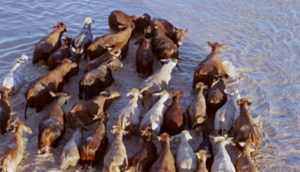Read the latest information on
Foot-and-mouth disease
 Australia’s reputation for droughts and flooding rains has been hammered home over the last few years, especially to those who make a living on the land. Having a business continuity plan that includes what you’ll do when in a crisis and how you’ll manage biosecurity risks is a great way to help minimise impacts of extreme events like the 2020 Black Summer Bushfires.
Australia’s reputation for droughts and flooding rains has been hammered home over the last few years, especially to those who make a living on the land. Having a business continuity plan that includes what you’ll do when in a crisis and how you’ll manage biosecurity risks is a great way to help minimise impacts of extreme events like the 2020 Black Summer Bushfires.
As we begin to recover from the last summer’s disastrous fire season, we approach the opposite end of the spectrum, with the Bureau of Meteorology declaring a La Niña event for this summer. Across much of eastern and northern Australia higher-than-average rainfall is anticipated. On the plus side, the fire risk is expected to be lower. The downside is we must prepare for the possibility of flooding and stronger cyclones.
A business continuity plan – where you think forward to scenarios that are likely to play out through an extreme event and step out the critical actions you’ll take to protect your livelihood – is a really useful tool to have ready to go. If we have learned anything from 2020, it’s that good planning before a crisis hits can be a game changer for businesses and the crisis can be caused by a range of things including biosecurity, fires, and extreme weather.
Weather can also change biosecurity risks, according to Animal Health Australia’s Senior Manager Biosecurity, Dr Rob Barwell.
“While flooding itself can be a huge risk to your business, you need to consider the after-effects as well,” Dr Barwell explains.
“Anything that thrives in warm, wet conditions is likely to have a bumper year over the next 6 months, including weeds, soil- and water-borne diseases, biting insects and internal parasites. Anticipating these risks and acting early to minimise the damage is going to be crucial.”
While likely to be much diminished from the same time last year, the fire season will also be heating up, bringing with it potential loss of or damage to critical farm infrastructure. As such it’s incredibly important to pull together disaster management and biosecurity management into business continuity planning.
“If you do find yourself facing a natural disaster, having even a simple plan can help reduce the long-term impacts to your livestock,” Dr Barwell says.
“That means knowing where you can take your stock so they are out of harm’s way, knowing what you’ll need to have checked and fixed before you bring them back onto your property, and how you’ll monitor and manage their health afterwards.”
While 2020 has been a wild, fast-paced and difficult year, between drought, fires, smoke and a global pandemic, it’s important to take time where you can find it to plan ahead and divert an animal health crisis before it cripples your business.
“Forward-thinking and planning is 101 for any successful business and can keep yours afloat this summer.”
Find out more about biosecurity planning for your livestock enterprise on the Farm Biosecurity website.